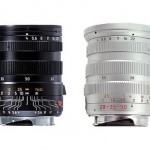-
Recent Posts
Popular Posts
 When Technique becomes Art ...September 23, 2015
When Technique becomes Art ...September 23, 2015 Street Photography is too often confused with "photography on the road"September 23, 2015
Street Photography is too often confused with "photography on the road"September 23, 2015 Discovering more about Lightroom CCMarch 30, 2017
Discovering more about Lightroom CCMarch 30, 2017
It’s not a zoom, it’s not a single focal length…. it’s Tri-Elmar; I love this lens. Now that we live in the digital age, this objective could find a second youth. The possibility of having three focal lengths, in a rangefinder, without having to change the optical means, in addition to a saving of time, less risk of soiling the sensor, greater readiness to shoot, less mechanical stress to the bayonet. I recommend it highly, finding it (unfortunately those who have rarely thrown them away and prices are “important”), who wants to devote himself to the street and travel reporting.
Because it is no longer produced? It seems that the complexity and costs of production are so high that they do not have a sufficiently attractive market.
I invite you all to read how E.Puts wrote (2002) about this. ENJOY!
“Leica Tri-Elmar ASPH 28-35-50/4″
This lens is very important in several ways. Its three focal length (28-35-50) selection brings zooming convenience to the M-rangefinder line-up. It takes a while to become accustomed to its three ring handling (aperture selection- distance selection and focal length se- lection). The focal length selection ring is close to the distance setting ring and when in a hurry it is easy to mix things up. After some use (it took me a day) your fingers ‘know’ the right locations intuitively. The convenience of having three focal lengths at swift disposal would be useless for the critical Leica M user if the optical performance were below par.
General Optical Performances
I tested the Tri-Elmar-M in comparison with the 28mm Elmarit-M current and third generation, the 35mm ASPH and last non-ASPH version and the current 50mm Summicron. As I always use the same test method I can easily refer to the older generations as well.
First surprise: the Tri-Elmar-M hardly improves on stopping down and this statement is true for all three focal lengths. This behavior is only possible in a very well corrected optical system. It also means that the Tri-Elmar-M exhibits excellent optical performance at its full aperture. Admittedly not as wide as its fixed focal length brothers and sisters, but we will take up this issue at the end of this section.
Not every person will like the conclusion, but the Tri-Elmar-M is clearly superior in all optical parameters to many Leica lenses of the 28, 35 and 50mm focal lengths. With the exception of the aforementioned 5 lenses (28 current and 3rd generation, 35 ASPH and immediate predecessor: (the 7 element Summicron) and the current 50mm Summicron) the Tri-Elmar-M will outclass any other Leica lens of the 28, 35 and 50 focal length of previous generations by a large margin.
Second surprise: in many picture-taking situations its performance is equal to that of current Leica lenses of 28, 35 and 50mm focal length. There are obvious and visible differences between the Tri-Elmar- M and its current fixed focal length companion lenses. To appreciate the relative importance of these differences I would like to draw a distinction between two types of Leica M use. Note that this a distinction between styles of use and not between users. The same person in one situation will demand superior optical performance and in another situation this person will be more concerned with capturing the fleeting moments of passion and life. Leica M users are fortunate that their equipment supports both styles eminently.
The performance of the Tri-Elmar-M at 50mm: the lens gives a high contrast image with fine and very fine details rendered crisply. Extremely fine details have somewhat softer edges, but are still quite visible. This performance extends over a circular image area with a diameter of 12mm (the center area). In the outer zones (the image circle from 9 to 16mm from the midpoint) the contrast drops a little and the very fine de- tails become slightly softer. Some astigmatism lowers the contrast here. The extreme outer area and corners are soft with fine details just visible. Stopping down to f/5.6 brings somewhat more contrast and better definition of extremely fine details.
This performance level continues until after f/11 where diffraction softens the details and lowers the contrast. Close-up capabilities (1.2 meter) are very good with a contrast image showing crisply rendered fine details over the whole image field. At 35 mm: at full aperture the contrast now is a bit lower and very fine details are a bit softer.
Extremely fine details are just visible in the center, but in the outer zone barely so. The corners are on the same level as they are in the 50 mm setting. Quite remarkable here is the uniform perform- ance over the total image field. The close-up performance again shows a high contrast image with excellent rendition of details over the whole image field. At 28mm: Leica states that the 50 position of the Tri-Elmar-M gives the best performance, and a slightly lower performance at the 28 setting. Indeed distortion is a bit greater than it is at the 35 and 50 settings. When photographing flat objects like walls, some barrel distortion is clearly noticeable. When picturing architectural objects with depth, this effect mostly vanishes. At full aperture fine details are rendered with medium to high contrast in the center and contrast is a little lower in the outer zone. Very fine details are clearly visible and become somewhat softer in the outer zones. At close-up distances the image is of the same high contrast and uniformity of field as it is at the other settings. Here, as with the 35 and 50 settings, stopping down increases contrast but the correction of aberrations is already of such a high level that image details and textural details only improve a little.
Comparison to the fixed focal lengths.
These lenses excel of course with excellent to outstanding performance at the wide apertures of 2.0 and 2.8. At f/4.0 they are at thier optimum and then they are comparable to the Tri-Elmar-M at nearby its optimum. For all focal lengths we can give this conclusion, based on the f/4,0 performance. The fixed focal lenses perform a little better than the Tri-Elmar-M in the image quality at the level of extremely fine details and the performance in the outer zones and far corners. The overall contrast of the fixed focal lenses too is a shade better, giving the pictures slightly more clarity. Very careful comparison of the pictures (low speed slide film at 30 x) taken with the Tri-Elmar-M and its com- panions shows these performance differentials in contrast and the quality at the level of extremely fine details. The Tri-Elmar-M shows remarkable suppression of flare and night shots taken on the 28 position give very good clarity of highlights and shadows with good rendition of details and only faintly visible coma in the extreme outer zone.
For most users, who will shoot casually or who do not demand the utmost of enlargements or projection distances, the performance differences are immaterial and will not be of any importance. The very demanding user might note the differences but it is a matter of personal preference how to rate these quality differences.
Conclusion.
Is the Tri-Elmar-M a replacement for three top class fixed focal length lenses? The answer is obviously not easy. Its full aperture of f/4.0 has its limitations. Especially when using low speed films. Its compact design consti- tutes an attractive alternative to three popular focal lengths and in this respect it performs outstandingly well. The smooth and quick changing of focal length brings many picture-taking opportunities that would be lost if you had to change several lenses. And the critical Leica user can use these new possibilities in the secure knowledge that the resulting pictures will show all the qualities for which Leica lenses are famous. And it may even captivate the most critical users of older generations of Leica lenses in the 28 to 50mm focal length group. Weighing only 330 grams (less than 12 ounces), it is a very convenient lens with excellent performance that the older lenses simply cannot match. The modern and current generations are able but hard-pressed to surpass this level of performance at f/4 and smaller. The Leica user who needs outstanding performance at apertures wider than f/4,0 and/or big enlargements showing the smallest image details with great clarity and contrast needs to change lenses and after many years might wear out the bayonet flange.
 When Technique becomes Art ...
When Technique becomes Art ... Street Photography is too often confused with "photography on the road"
Street Photography is too often confused with "photography on the road" Discovering more about Lightroom CC
Discovering more about Lightroom CCVinicio Tassani
reportage, portrate, bookcell.: +39.380.3158202
info@viniciotassani.it
